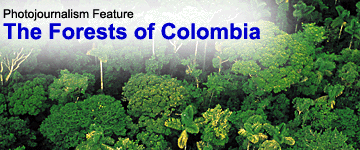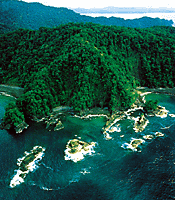 | 
| ||||||
 | Forest in Uraba, Northern Colombia | |||||
 Cattleya warscewiczii  Pleurothallis titan | The forests of Colombia are home to the most beautiful orchids... cattleya, masdevallia, odontoglossum. Each is the reflection of a particular place, shaped by the wind and rain, the sun and clouds and its forest companions. Colombia may be the biologically richest country in the world. Perhaps a third of its 55,000 plant species are endemic -- growing nowhere else. And there are nearly 3,500 orchids or 15% of the world's species. Yet Colombia is undergoing large-scale deforestation -- losing 1.5 to 2.2 million acres each year. At this rate, its forests will disappear within 40 years. The extinction rate for Colombian plant and animal species is increasing,  and the traditional life of the indigenous people is being destroyed. and the traditional life of the indigenous people is being destroyed.����Colombia's Pacific coast is unparalleled in plant biodiversity. Under "Plan Pacifico" -- Colombia's ambitious plan for extraction and exportation of the natural resources of the Pacific region, 395,000 acres are destroyed each year for wood or for planting African oil palms. (Photo: Pacific Coast of Northern Colombia)  ��������Frankilina, an Embera Catio Indian of Uraba. The Pan American Highway cut through her people's land in the 1980's, opening their forest home to development. Like the Embera Catio, many native peoples of Colombia have been displaced by immigrants, logging, mining, oil extraction, the drug trade, and warfare. |  Stanhopea shuttleworthii 'Green'  Restrepia cuprea  Cisweinfia dasyandra | ||||
 Masdevallia auropurpurea | ����Letters From a Colombian Conservationist During a recent survey on the orchid flora of the southern Andes in Narino, we found that a mature, pristine montane forest (8000-9000 feet elev.) contains between 37,000 and 53,000 orchid plants per acre, in fourteen genera, including Odontoglossum and Masdevallia. These forests are dominated by huge Clusia multiflora trees, with mangrove-like roots, some of them completely covered by Masdevallia plants. It is one of the few places where you can say orchids are the dominant species in the landscape; it is incredible. These forests are being destroyed very fast by local peasants to make charcoal for the local chicken roasteries. They believe Clusia makes the best charcoal. They make 100 bags of charcoal from an acre, and receive less than two dollars per bag. Orchids and all other species are left to rot and the place looks like a battlefield afterwards. One does not know if to cry or become mad. Fortunately we were able to set up around 40 private reserves in the area. | Cattleya aurea | ||||
|  | |||||
| Colombia photos by Aldo Brando | Elsewhere in Colombia, the authorities -- aided by U.S. funding, are spraying the jungles, coca crops and Indian reservations with Round-up herbicide using airplanes. Can you imagine such a destructive activity? Right in the center of world biodiversity. The most sensitive to it are the epiphytes, orchids -- of course. | |||||
Ordering Information Tropical Orchid Farm, Inc. • P.O. Box 170 • Haiku, Maui, HI 96708 • Toll Free (866) 572-8569 • Fax (808) 572-8917 © 2002-2024 Tropical Orchid Farm, Inc. All rights reserved. It is illegal to copy or otherwise distribute any of the content or photography on this site for personal, commercial or any other use. |